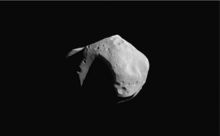C-type asteroid
This article needs additional citations for verification. (June 2010) |

C-type asteroids are carbonaceous asteroids. They are the most common variety, forming around 75% of known asteroids,[1] and an even higher percentage in the outer part of the asteroid belt beyond 2.7 AU, which is dominated by this asteroid type. The proportion of C-types may actually be greater than this, because C-types are much darker than most other asteroid types except D-types and others common only at the extreme outer edge of the asteroid belt.
Characteristics
Asteroids of this class have spectra very similar to those of carbonaceous chondrite meteorites (types CI and CM). The latter are very close in chemical composition to the Sun and the primitive solar nebula, except for the absence of hydrogen, helium and other volatiles. Hydrated (water-containing) minerals are present.[2]
C-type asteroids are extremely dark, with albedos typically in the 0.03 to 0.10 range. Consequently, whereas a number of S-type asteroids can normally be viewed with binoculars at opposition, even the largest C-type asteroids require a small telescope. The potentially brightest C-type asteroid is 324 Bamberga, but that object's very high eccentricity means it rarely reaches its maximum magnitude.
Their spectra contain moderately strong ultraviolet absorption at wavelengths below about 0.4 μm to 0.5 μm, while at longer wavelengths they are largely featureless but slightly reddish. The so-called "water" absorption feature around 3 μm, which can be an indication of water content in minerals is also present.
The largest unequivocally C-type asteroid is 10 Hygiea, although the SMASS classification places the largest asteroid, 1 Ceres, here as well, because that scheme lacks a G-type.
C-group asteroids
C-group (Tholen)
In the Tholen classification, the C-type is grouped along with three less numerous types into a wider C-group of carbonaceous asteroids which contains:[citation needed]
C-group (SMASS)
In the SMASS classification, the wider C-group contains the types:[citation needed]
- B-type corresponding to the Tholen B and F-types
- a core C-type for asteroids having the most "typical" spectra in the group
- Cg and Cgh types corresponding to the Tholen G-type
- Ch type with an absorption feature around 0.7μm
- Cb type corresponding to transition objects between the SMASS C and B types
See also
References
- ^ Gradie et al. pp. 316-335 in Asteroids II. edited by Richard P. Binzel, Tom Gehrels, and Mildred Shapley Matthews, Eds. University of Arizona Press, Tucson, 1989, ISBN 0-8165-1123-3
- ^ Norton, O. Richard (2002). The Cambridge Encyclopedia of Meteorites. Cambridge: Cambridge University Press. pp. 121–124. ISBN 0-521-62143-7.
- S. J. Bus and R. P. Binzel Phase II of the Small Main-belt Asteroid Spectroscopy Survey: A feature-based taxonomy, Icarus, Vol. 158, pp. 146 (2002).
